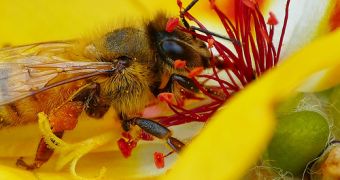A new study carried out by the University of Toronto, shows there is a decrease in bee pollination in Canada, mainly due to climate change.
Even though in Canada, there are over 1000 native species of bees, the most important pollinator – the honeybee, is not one of them.
Honeybees were brought from Eurasia, where they have been domesticated for centuries, and the Canadian “wild” honeybees are simply from colonies having escaped from domesticated hives.
James Thomson, a scientist with University of Toronto's Department of Ecology and Evolutionary Biology, has been carrying out a 17-year old examination of the wild lily in the Rocky Mountains of Colorado.
This is one of the longest-term studies of pollination that was ever done, and it allowed him to notice several phenomena.
“Bee numbers may have declined at our research site,” he said “but we suspect that a climate-driven mismatch between the times when flowers open and when bees emerge from hibernation is a more important factor.”
The survey pointed out a progressive decline in pollination during the past years, and especially in the early season.
Thomson began this study in the late 80's after buying a piece of land and building a log cabin in the middle of a hayfield filled with glacier lilies.
Three times a year, he compared the fruiting rate between flowers that were pollinated by hand and those that were pollinated naturally, and found that, over the years, there was a decline in pollination early in the flowering season, that kept accentuating.
He said that “early in the year, when bumble bee queens are still hibernating, the fruiting rates are especially low”, and “this is sobering because it suggests that pollination is vulnerable even in a relatively pristine environment that is free of pesticides and human disturbance but still subject to climate change.”
Apparently, bees are out of sync with the flowering period of glacier lilies, which lasts for nearly four weeks, from May to June, and this leads to less plants being pollinated and bearing fruit.
If this phenomenon was to be spread worldwide, than a third of the world's fruits and vegetables would no longer exist.
This study was supported by the US National Science Foundation and the Natural Sciences and Engineering Research Council of Canada, and was published today, in Philosophical Transactions of the Royal Society B: Biological Sciences.

 14 DAY TRIAL //
14 DAY TRIAL //